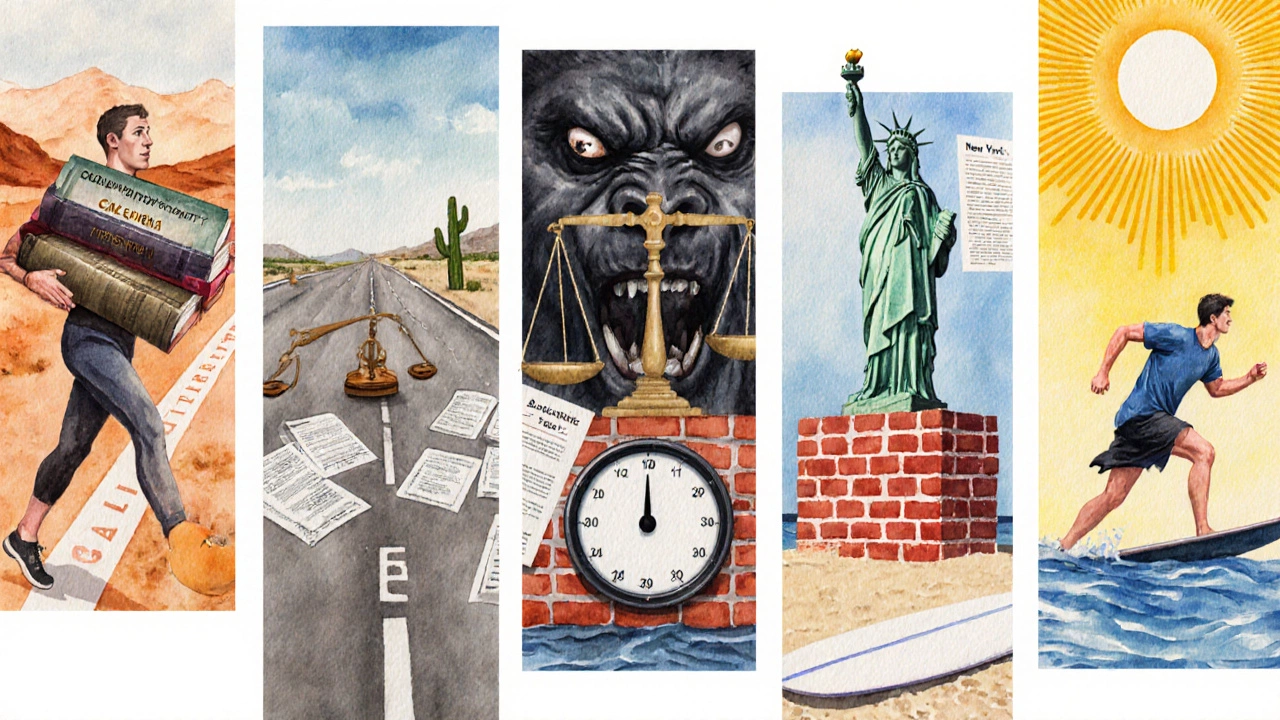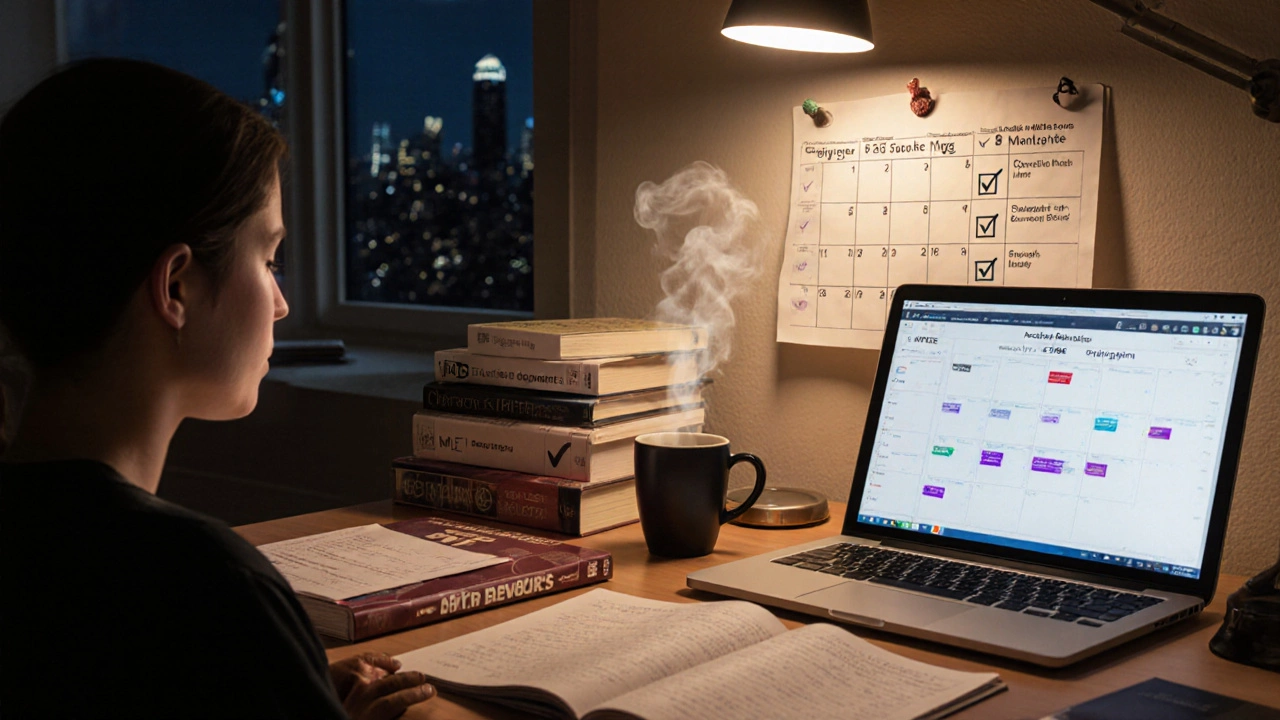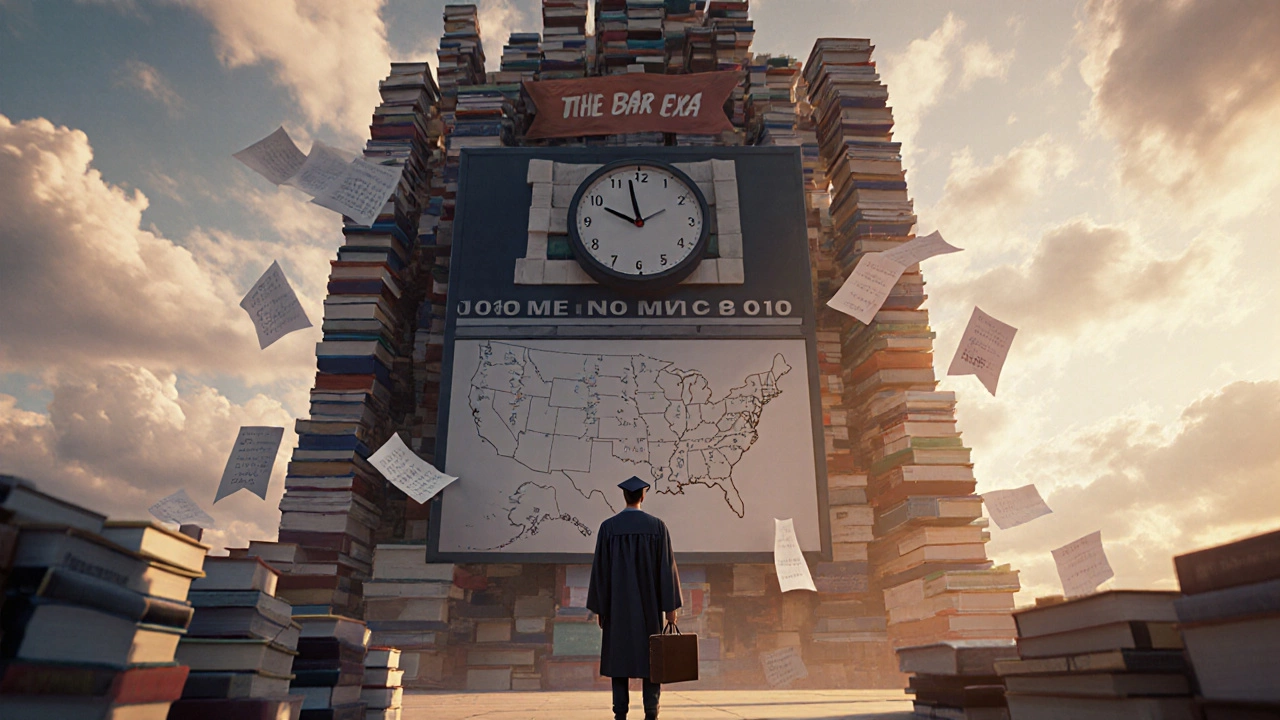Bar Exam Difficulty Comparison Tool
Compare State Bar Exams
Select states to compare their bar exam difficulty based on key metrics:
Bar Exam Comparison Results
| State | Pass Rate | MBE Score Required | Additional Components | Total Exam Days |
|---|
Key Insights
The table above shows a comparison of the selected states' bar exams. Lower pass rates and higher MBE score requirements generally indicate a more difficult exam. The number of additional components (like essays, performance tests, MPRE) also increases the difficulty.
Ever wondered which state makes the biggest hurdle for anyone wanting to practice law? The answer isn’t a simple "California" or "New York" - it’s a mix of pass‑rate stats, exam format, and extra requirements that turn the bar into a true endurance test. In this guide we’ll break down exactly what makes a state bar exam tough, rank the five hardest states, and give you concrete tips to survive even the steepest climb.
What is the Bar Exam?
Bar Exam is a comprehensive, multi‑day test that determines whether a law graduate meets a jurisdiction’s standards for legal practice. The exam usually combines the Multistate Bar Examination (MBE), state‑specific essays, performance tests, and sometimes the Multistate Professional Responsibility Examination (MPRE). Passing the bar earns you the title of "Attorney at Law" and grants you the right to appear in a state’s courts.
Why Do State Bar Exams Vary So Much?
Each state’s supreme court or board of law examiners sets its own rules. Some states lean heavily on the MBE, while others emphasize long‑form essays on local law. The differences affect study time, cost, and, most importantly, the likelihood of passing. Below are the main factors that push a state into the "hardest" category:
- Pass Rate: The lower the historical pass rate, the tougher the exam.
- Scoring Threshold: Some states require a higher scaled score on the MBE (e.g., 140 out of 200) or a combined score that exceeds the national average.
- Exam Length & Format: More days, more questions, and performance tests increase fatigue.
- Additional Requirements: Mandatory MPRE, character and fitness interviews, or a separate state‑specific component can add hurdles.
Data Snapshot: The Five Hardest State Bar Exams (2024‑2025)
| State | 2024 Pass Rate | MBE Score Requirement | Additional Components | Total Exam Days |
|---|---|---|---|---|
| California | 38% | 140 (scaled) | Three essays, Performance Test, MPRE | 3 |
| New York | 44% | 130 (scaled) | Two essays (NY law), MPRE, Character & Fitness | 2 |
| Texas | 45% | 135 (scaled) | Essay on Texas law, MPRE | 2 |
| Massachusetts | 41% | 138 (scaled) | Four essays, MPRE, 2‑hour Performance Test | 3 |
| Florida | 46% | 132 (scaled) | Two essays, MPRE, Skills Test | 2 |

State‑by‑State Deep Dive
California - The Marathon
California’s bar exam is a three‑day ordeal covering the MBE, essay questions, and a 90‑minute performance test. Its pass rate consistently hovers below 40%, making it the most unforgiving jurisdiction. The state also requires a minimum MBE scaled score of 140, which is higher than the national average. Prospective lawyers often report that the sheer volume of material - from Community Property law to California Evidence - is the biggest stumbling block.
New York - The Balanced Beast
New York’s exam spreads over two days and splits focus between the MBE and New York‑specific essays. The pass rate sits around 44%, but the state’s strict 130‑point MBE threshold and a mandatory MPRE (score of 85) tighten the margins. The character‑and‑fitness review also adds a non‑testing hurdle that can derail candidates with incomplete paperwork.
Texas - The Lone Star Challenge
Texas requires a 135‑point MBE score and an essay section that zeroes in on Texas statutes and case law. The pass rate is slightly better at 45%, yet the state’s emphasis on local law means out‑of‑state students must spend extra time mastering Texas-specific nuances. The exam’s format is straightforward, but the high scoring bar raises the difficulty level.
Massachusetts - The Academic Sprint
Massachusetts packs four essay questions, a performance test, and the MBE into a three‑day schedule. With a pass rate of 41% and an MBE requirement of 138, the state’s bar is known for its rigorous grading. The performance test, which asks examinees to complete a realistic legal task (e.g., drafting a memorandum), is often cited as the toughest segment.
Florida - The Sunshine Test
Florida’s exam is two days long, featuring the MBE, two essays, and a 90‑minute Skills Test that mimics real‑world legal drafting. Although the pass rate sits at 46%-the highest among the five-Florida still demands a 132‑point MBE score and a passing MPRE. The Skills Test is a curveball that catches many candidates off guard.
What Makes a State the hardest state to become a lawyer?
Beyond raw numbers, a few hidden factors tip the scale:
- Curricular Alignment: States that test on obscure local statutes force candidates to buy state‑specific prep courses, inflating costs.
- Exam Logistics: Three‑day exams increase fatigue, especially when performance tests are placed on the final day.
- Scoring Policies: Some jurisdictions use a "cut‑score" that’s higher than the national average, effectively raising the bar (pun intended).

Tips to Conquer the Toughest Bar Exams
- Start Early: Give yourself at least six months of dedicated study. The first three months should focus on the MBE, the next two on state essays, and the final month on performance tests.
- Use State‑Specific Prep Materials: For California, enroll in a prep course that covers Community Property law. For New York, practice essay prompts that mirror the "New York Law" format.
- Simulate Exam Conditions: Take full‑length practice exams on consecutive days to mimic the stamina required for three‑day exams.
- Master the MPRE Early: Since the MPRE is a separate 50‑question multiple‑choice test, schedule a dedicated study block at least three months before the bar.
- Stay Organized with a Checklist: Track required documentation for the character and fitness review to avoid last‑minute surprises.
Key Takeaways
- California, New York, Texas, Massachusetts, and Florida rank as the five hardest states based on pass rates and scoring thresholds.
- Low pass rates often correlate with higher MBE cut‑scores, extra essay components, and performance tests.
- Early, structured preparation and state‑specific resources are essential for success.
- Don’t underestimate the MPRE and the character‑and‑fitness process; they can be deal‑breakers.
- Simulating real exam conditions builds the stamina needed for multi‑day bar exams.
Frequently Asked Questions
Which state has the lowest bar exam pass rate?
California consistently records the lowest pass rate, hovering around 38% for the 2024 cohort.
Do all states require the MPRE?
Almost every jurisdiction, including the five hardest states, mandates a passing score on the MPRE. The required score varies, but it’s typically 85‑90.
Can I take the bar exam in a state where I didn’t go to law school?
Yes. Most states allow graduates from ABA‑accredited schools to sit for the exam, but some, like New York, have additional requirements for foreign‑trained or non‑US law graduates.
How much does bar exam preparation cost?
Preparation courses range from $1,200 for basic MBE packages to $4,500 for comprehensive state‑specific programs that include essay and performance‑test coaching.
Is the bar exam difficulty consistent over time?
Difficulty fluctuates with changes in scoring policies and exam format. However, states like California and Massachusetts have maintained low pass rates for a decade, indicating a consistently high bar.
